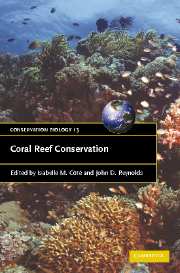Book contents
- Frontmatter
- Contents
- List of contributors
- Foreword
- Preface
- Part I Setting the stage
- Part II Uses and abuses: ecological and socio-economic issues
- Part III The way forward: tools and approache
- 9 New approaches to estimating recent ecological changes on coral reefs
- 10 Assessing the effectiveness of marine protected areas as a tool for improving coral reef management
- 11 Environmental impact assessment for coral reefs: advocating direct protective approaches
- 12 Time for a third-generation economics-based approach to coral management
- 13 Collaborative and community-based conservation of coral reefs, with reference to marine reserves in the Philippines
- 14 Education as a tool for coral reef conservation: lessons from marine protected areas
- 15 Adaptive institutions for coral reef conservation
- 16 Coral reef restoration with case studies from Florida
- 17 Redesigning coral reef conservation
- 18 Coral reef coda: what can we hope for?
- Index
- Plate section
- References
11 - Environmental impact assessment for coral reefs: advocating direct protective approaches
Published online by Cambridge University Press: 05 June 2012
- Frontmatter
- Contents
- List of contributors
- Foreword
- Preface
- Part I Setting the stage
- Part II Uses and abuses: ecological and socio-economic issues
- Part III The way forward: tools and approache
- 9 New approaches to estimating recent ecological changes on coral reefs
- 10 Assessing the effectiveness of marine protected areas as a tool for improving coral reef management
- 11 Environmental impact assessment for coral reefs: advocating direct protective approaches
- 12 Time for a third-generation economics-based approach to coral management
- 13 Collaborative and community-based conservation of coral reefs, with reference to marine reserves in the Philippines
- 14 Education as a tool for coral reef conservation: lessons from marine protected areas
- 15 Adaptive institutions for coral reef conservation
- 16 Coral reef restoration with case studies from Florida
- 17 Redesigning coral reef conservation
- 18 Coral reef coda: what can we hope for?
- Index
- Plate section
- References
Summary
INTRODUCTION
Arguably, there is little that coastal zone managers can do to minimize the impact of natural disturbances to coral reefs, such as cyclones and hurricanes, boom and bust in echinoderm populations, coral bleaching, disease and climate change (Bellwood et al., 2004). However, protection can be afforded to reefs from degradation arising from the construction and operation of coastal developments such as marinas, prawn farms, desalination plants, sewage treatment works, hotels and other large-scale developments, thereby maximizing the resilience of reefs to natural perturbations. Coral reefs occur adjacent to many rapidly developing regions, and it is important not to allow concerns over large-scale natural impacts to diminish the need for continued protection of reefs at the national, regional and local levels (Wilkinson, 2004; Jaap, this volume).
Environmental impact assessment (EIA) is a tool that can be used to identify the likely impacts from human activities before they arise (Clark, 1996), and to put into place measures to minimize damage from those impacts that are unavoidable. Monitoring during both construction and operation is essential to determine whether mitigation measures work (Lincoln-Smith, 1991). EIA is a powerful environmental protection device if the assessment is undertaken thoroughly, and all recommendations are followed by the developer and operator, and enforced by the regulating authority. Unfortunately, EIA is often inadequate (Fairweather, 1989, 1993) or worse, not carried out, and coral reefs are needlessly degraded by developments, devaluing their role in coastal protection (Sheppard, this volume), fisheries (McClanahan, this volume), tourism (Jobbins, this volume) and as repositories of biodiversity.
- Type
- Chapter
- Information
- Coral Reef Conservation , pp. 332 - 361Publisher: Cambridge University PressPrint publication year: 2006
References
- 1
- Cited by



